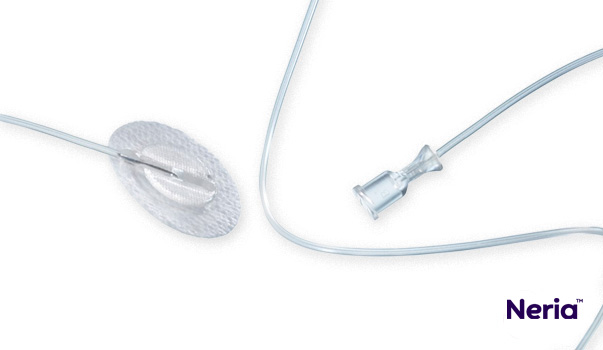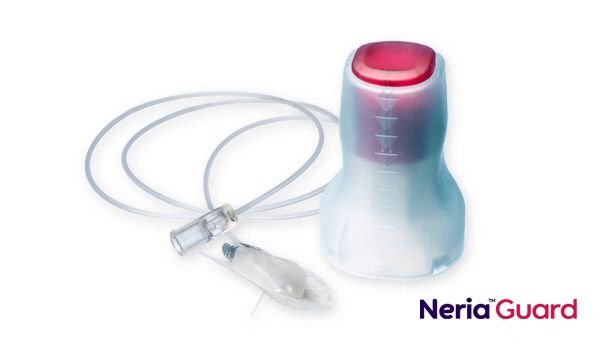INTRA PUMP
INFUSION SYSTEMS
FOR SUBCUTANEOUS
ADMINISTRATION
Intra Pump Infusion Systems. For Quality of Life.
Intra Pump Infusion Systems is a company which distributes a specialized line of personal medical pumps and devices providing solutions for infusion and injection therapy. We are the source for the Crono family of infusion pumps which are uniquely designed for specific therapies and have a high degree of accuracy and reliability. We are also the source for subcutaneous infusion sets as well as the only angled indwelling cannula designed to improve patient compliance and reduce pain associated with multiple daily injections.
Intra Pump Infusion Systems
Support
Looking for product information, like User Manual, Short Instructions, Brochure and more… You’ll find it all here.
Resources
Need more help ?
You’ll find links to external resources to help you and assist you right here.
Product Details
Looking for product information about Crono Infusion Pumps, Neria Infusion Sets or Insuflon Injection ports? You’ll find it here.
Clinical Trials
Intra Pump Infusion Systems
Intra Pump Infusion Systems
Intra Pump is one of the leading suppliers in the US of systems dedicated to the subcutaneous administration of drugs for a variety of clinical purposes. Among the therapies which benefit from these systems are included:
WHY USE A PUMP?
Associated products: CRONO Super PID | CRONO S-PID 50
PRIMARY IMMUNODEFICIENCIES
Primary and secondary immunodeficiencies
Immunodeficiencies are a group of more than – 250 disease’s in which the immune system loses all or part of its functionality.
Normally, the immune system protects the human body from pathogenic micro-organisms (such as bacteria, viruses and fungi) that can cause infectious diseases.
When part of this system fails or is absent, the patient contracts infections more frequently and takes longer to heal from them.
Primary-immunodeficiencies (PIDs)-occur when the defect in the immune system is of genetic origin.
In addition to being very numerous, primary immunodeficiencies are characterized by non-specific symptomsthatcomplicate the recognition of the diseaseby doctors.
In immunodeficiencies associated withantibody deficiency, thepreferred treatment is represented byreplacement therapy with immunoglobulins, whose timely start is essential to avoid the onset of irreversible damage caused by infections to organs and systems.
Secondary immunodeficiencies (SID) are caused by various factors such as, for example, malignant tumors, in particular those affecting the hematopoietic and lympho-reticular system.
Other causes can be metabolic diseases and / or malnutrition.
Immunoglobulin therapy is used in the treatment of hypogammaglobulinemia associated with chronic lymphocytic leukemia (CCL) and multiple myeloma (MM), often due to concomitant immunosuppressive therapies.
These patients may benefit from immunoglobulin replacement therapy in addition to the standard treatment required for their primary disease.
Currently available therapies vary according to the severity of the disease.
One of these is the administration (intravenously or subcutaneously) of immunoglobulins.
The administration of intravenous immunoglobulins represented an important change in the natural history of these diseases, drastically reducing infectious episodes and thus improving the quality of life of patients.
With intravenous replacement therapy, a high plasma immunoglobulin peak is rapidly achieved, maintaining a protective circulating antibody level with an infusion every 3-4 weeks in a hospital setting.
Subcutaneous immunoglobulin replacement therapy is a type of administration already attempted in the past.
In recent years it has been revived by making small adjustments that have increased its compliance by patients with primary immunodeficiencies.
A portable infusion pump is used which infuses the drug through a small needle inserted into the subcutaneous tissue of the abdomen, shoulders or thigh.
Since the infusion site is the subcutis, the amount of immunoglobulins that can be infused is less than with intravenous administration and absorption is slower; consequently multiple short-term monthly home infusions with infusion pump are required (every 7-15 days).
However, with these short and frequent administrations, subcutaneously infused immunoglobulins have a longer circulatory survival than intravenous infused ones, with an ability to maintain stable serum levels for longer and typically plateau pharmacokinetics without the peak of the intravenous infusion. .
Home therapy with subcutaneous immunoglobulins in diseases characterized by antibody deficiencies or which require immuno-modulation has several advantages over standard hospital intravenous therapy:
- Venous access not necessary.
- Hospital access to particularly fragile patients is avoided, avoiding exposure to possible infections.
- Possibility to carry out infusions at home using a portable infusion pump, thus reducing the frequency of visits to the hospital and guaranteeing savings in and lower costs for patients.
- Reduction of infusion times: the subcutaneous infusion takes about 30-60 minutes compared to the 3-4 hours required for intravenous administration of immunoglobulins.
- During the subcutaneous infusion of immunoglobulins the patient can move and carry out the normal activities of daily life, thanks to the fact that the infusion pump, if small, can be easily transported.
- Typically local side effects following subcutaneous immunoglobulin infusion are minor and moderate compared to those possible with intravenously infused immunoglobulins (muscle aches, fever, chills, headache, nausea, vomiting, anaphylactic shock).
- Economic advantage that this technique seems to bring both for families with relatives affected by primary immunodeficiencies, and for the health system.
- Frequent infusions of subcutaneous immunoglobulins allow to generate a local deposit that ensures an almost constant level of IgG over time, guaranteeing a more prolonged protection against infections while maintaining constant protective levels.
Associated products:
CRONO Super PID | CRONO S-PID 50 | Neria | Neria Multi | Neria Soft | Neria Guard
PAIN MANAGEMENT
A major goal of palliative care is comfort, and care at the end of life should be responsive to the personal needs and preferences of the patient. The subcutaneous (SC) route has become a favored route of administration in palliative care due to its flexibility, safety and practicality.1 The SC route is particularly useful for patients with dysphagia, nausea and vomiting, or bowel obstruction.2,3
Infusion Therapy
Best practice in pain management is to use the least invasive route of administration for the prescribed opioid. Due to this, in most cases patients are introduced to opioid pain management in a short acting formulation that is taken orally.4 However, if the pain continues, or in cases of severe pain, patients may be prescribed stronger opioids by oral administration. If patients are unable to take medication orally, then opioids may be administered by injection or continuous infusion. Subcutaneous infusion of opioids is considered preferable, as it is less invasive and may be better tolerated than intravenous infusion and less painful than intramuscular injection.
neria™ infusion sets for Pain Management and Palliative Care
Relief and comfort are key focal points in pain management, especially in palliative care. Therefore, the soft cannula range of neria infusion sets are frequently recommended for infusions. These infusion sets have a disconnect feature which make them convenient to use during long infusion periods.
In general, however, the choice of infusion set should always be based on the health care professional’s assessment of each individual patient’s situation.
neria™ infusion sets have been tested for safe use with hydromorphone, morphine sulfate and morphine chloride for pain management.5
1.Kestenbaum MG et al. Alternative routes to oral opioid administration in palliative care: a review and clinical summary. Pain Medicine 2014;15:1129-1153, 2. Mercadante S et al. Alternatives to oral opioids for cancer pain. Oncology 1999;13:215-25, 3. Anderson SL et al. Continuous subcutaneous infusion of opiates at end-of-life. Ann Pharmacother 2004;38:1015-23, 4. WHO web site, www.who.int/cancer/palliative/painladder/en/, 5. Statement – Overview of Drug/Device Compatibility Test for the neria™ Range. 24. February 2020. AP-020446-MM. Data on file.UnomedicalA/S.
Associated products: Neria Soft | Neria Guard
PAROXYSMAL NOCTURAL HEMOGLOBINURIA (PNH)
Paroxysmal nocturnal hemoglobinuria (PNH) is an acquired, rare, chronic, and potentially life-threatening blood disease that is associated with persistently low (below normal) hemoglobin levels, thrombosis, and debilitating symptoms. PNH can appear at any age and in any race or gender, and is most often diagnosed in people in their early 30s.1,2
In PNH, blood cells lack complement regulatory proteins, so the body recognizes these healthy red blood cells as damaged.1 This leads to uncontrolled activation of the complement cascade, initiated at C3, and results in the destruction of oxygen-carrying red blood cells (hemolysis).3 Hemolysis occurs in PNH through two mechanisms: intravascular hemolysis (IVH), which occurs inside blood vessels, and extravascular hemolysis (EVH), which occurs in the liver and spleen.
PNH is not cancer. PNH is a rare blood disease. Blood cells originate in-bone marrow. While there are diseases involving bone marrow that are cancer, such as leukemia, PNH is not one of them. Doctors who specialize in treating PNH may also treat people with cancer or work at centers that focus on treating people with cancer, but PNH should not be confused with cancer.
PNH is not inherited and can’t be passed on to others. PNH is acquired, which means the genetic mutations responsible for the disease happen during your life. You are not born with them, and you cannot pass them on to others.
Associated products: CRONO Super PID | Neria | Neria Multi
THALASSEMIA
Introduction to Thalassaemia
Thalassaemia is a genetic blood disorder where the body makes an abnormal form of hemoglobin – the protein in red blood cells that carries oxygen throughout the body.
Patients diagnosed with Thalassaemia may require regular blood transfusions to raise their hemoglobin blood levels. This can lead to iron build-up in the body’s tissue and organs – also referred to as iron overload. As iron can be toxic, too much of it can damage tissue. Excessive iron accumulates in the heart, liver, lungs, brain, and other organs, which highly increases the risk of other diseases and even life-threatening conditions.
If a patient with Thalassemia is experiencing iron overload from frequent blood transfusions, they may require an iron removal or chelation therapy. One medication approved for this is Desferal’, which is infused subcutaneously using an infusion pump and infusion set. Desferal’ is given over a 8-12 hour period, often overnight. The treatment can be performed daily, or 5-7 times a week.*
*According to Desferal’-Summary of Product Characteristics (SPC) by Novartis Pharmaceuticals UK Ltd.
Associated products: CRONO Super PID | CRONO S-PID 50 | Neria | Neria Guard
SITE DEVELOPMENT
These are areas of therapy where there is little information readily available. We would welcome any contributions which provide additional information on these topics, which we will publish and/or link to from these pages. Please email us or visit our contact page if you have something you would like to contribute.
Newsletter
Subscribe to our newsletter to stay in the know

IntraPump® Infusion Systems is a company which distributes a specialized line of personal medical pumps and devices providing solutions for infusion and injection therapy.
Quick Links
Contact Us
Feel free to contact us if you have any questions or comments to share with us.
If you need additional information on IntraPump® Infusion Systems products, please call us at: +1 (630) 845-7867
Copyright 2024 © Intra Pump® Infusion Systems.





